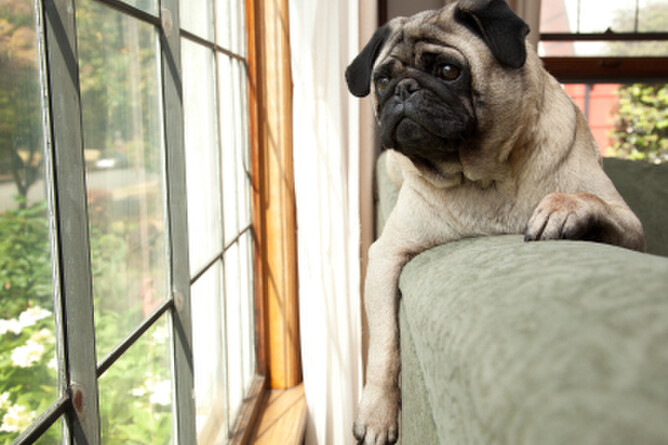What causes separation anxiety?
While it would be easier to attribute ripped furniture to this particular disorder, separation anxiety is very different from “bad” behaviour.
Separation anxiety can result from suffering a traumatic experience -- an earthquake, a car accident, or the death of a person or another pet in the household can sometimes trigger separation anxiety.
Major changes, such as moving, can also cause separation anxiety as your pup might become uneasy when thrown into unfamiliar surroundings.
And while separation anxiety isn’t exclusive to specific breeds, there are some dog breeds that seem to be at a higher risk than others. According to Los Angeles dog trainer/writer Katie Finlay, there are 12 breeds who are more susceptible to separation anxiety.
- German Shepherd
- Australian Shepherd
- Labrador Retriever
- Vizsla
- Border Collie
- Cocker Spaniel
- Bichon Frise
- Cavalier King Charles Spaniel
- Italian Greyhound
- Toy Poodle
- Havanese
- German Shorthaired Pointer
What does separation anxiety look (and sound) like?
We must remember that not all unwanted behaviours translate to separation anxiety -- actually, most don’t.
Most behaviours, such as chewing up your shoes, are more likely because your furry friend enjoys doing it out of boredom. And they get away with it because you’re not home.
Separation anxiety generally will include one or more of the following behaviors when you’re not at home:
- Destructive actions - chewing furniture, mutilating plants, or constant scratching at doors and windows
- Nonstop barking, whining, or howling
- Urinating or defecating inside your home
- Excessive, persistent pacing
- Attempting to “escape” a room to the point of self-injury
- Physiological reactions, such as dilated pupils or excessive panting
Other things to consider:
- Does this behaviour occur every time you leave? Only in your absence?
- Does your dog become anxious before you go? Are there tell-tale signs, such as the rattling of keys when you pick them up, that prompt your pup to begin pacing and howling?
So what do you do if your dog shows traits of these behaviours and actions?
Treat the problem
Desensitisation is the approach most often used to treat separation anxiety. Keep in mind, however, it will take some time. It’s all about taking little puppy steps. You have to get your dog used to you leaving .
It can take a month to two months to bring separation anxiety symptoms under control. Of course, it is a more severe case it will take longer.
The first step is to think of your process when you are about to leave - what do you do? What are the sights and sounds that your dog might associate with you leaving?
For example, get your dog used to hearing the sound of your keys rattling. When your pup can do that without showing any signs of distress, take another puppy step -- pick up your bag. Then add walking to the door. Then turning the doorknob.
Continue adding puppy steps until you can leave the house for a period of an hour or more without consequence.
If this seems like a long process, it is. In the meantime, keep your greetings and goodbyes as low-key and casual as possible. This signals to your dog that comings and goings are non-eventful, common occurrences.
Another technique is teaching your dog that leaving them alone actually means good things. The goal here is to associate your departure with something positive. For example:
- Leave a toy, like a Kong, stuffed with peanut butter ready for your pup to dig into as soon as you leave.
- Hide small treats around the house. Make sure favourite toys are tucked safely in places he knows to search. This gives your pup something to do while you’re gone and helps eliminate boredom.
- Tire your dog out. Give plenty of physical and mental exercise. This also allows for bonding time; and when you do leave, your dog will be more content to relax or snooze.
There a few ways to go about easing anxious behaviours, but just remember this: separation anxiety has little to do with training or discipline.These behaviours stem from the severe panic your dog feels when you’re not there. Left untreated, it can cause damage to your home and belongings as well as serious psychological suffering for your dog. If problems still persist after several attempts to correct them, it is recommended that you consult a professional.
Has your dog shown any signs of separation anxiety? Do you need some toys or treats to help ease the anxiousness? If you need help in fighting separation anxiety, give us a bell in store on 09 448 2227. We are here to help.

